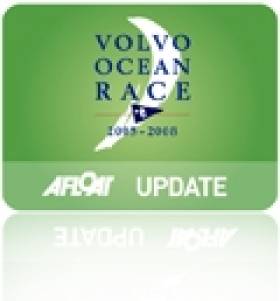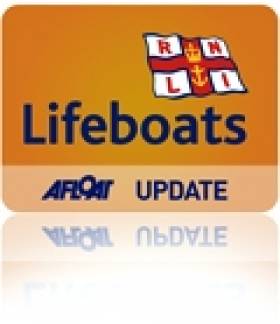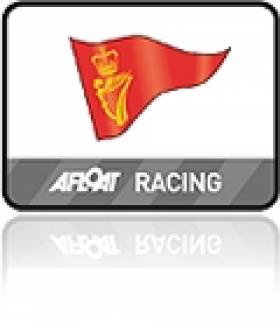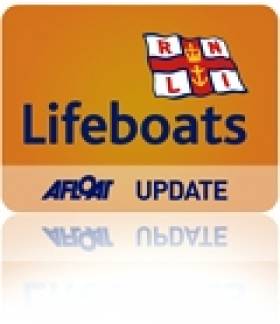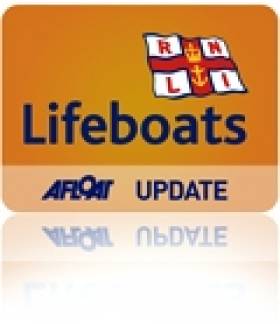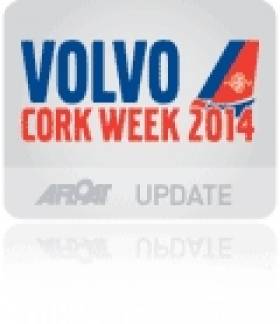Displaying items by tag: Crosshaven
Dubarry 'Crosshaven' Was Born at Sea Onboard Ireland's Green Dragon
#dubarry – During their gruelling experiences throughout the Volvo Ocean Race 2008/9, the crew of the Irish entry, Green Dragon, had modified a 'workshop enhanced' version of Dubarry's existing performance sailing boot 'Fastnet' by adding a fairly crude, improvised integral gaiter. On their return to Galway, Green Dragon crew members Ian Walker, Neal McDonald and Damian Foxall, along with key onshore support personnel, met with the Dubarry Design and Engineering team led by Design Director Brian Geraghty. Their 'enhanced' boot was the subject of extensive examination and discussions that enabled Dubarry to garner a very detailed understanding of what sailors demand when working in the most extreme conditions imaginable. It was from these meetings with those that know, love and respect the ocean that the Crosshaven concept was conceived.
Crosshaven's most striking feature is the integral gaiter. It is made with a lightweight, high abrasion, water repellant fabric with an adjustable draw-cord collar that secures foul weather gear and prevents wash back. It also houses a drainage mesh for optimal water release and features high-visibility bands. It is thermally insulated, utilising a 350g GORE-TEX® Duratherm membrane for extra warmth and waterproofness, combined with a thermally-lined footbed, which provides the boot with full insulation. Reinforced toe and heel parts utilise Dubarry's unique D-Chassis System. This two-part foot support system is inspired by Formula 1 racing technology and uses a moulded RPU frame that minimizes heel pronation by adding extra support, protection and control.
Crosshaven also has finger pulls for easy foot entry and ExtraFit™ sizing. The inner leg is constructed of Dubarry's DryFast-DrySoft™ leathers and Cordura®. These features, combined with our award-winning NonSlip-NonMarking™ durable outsole, make this a very special, ultra high-performance sailing boot indeed.
Crosshaven has gone on to become the sailing boot of choice for top crews across the globe, including Team Telefonica and Abu Dhabi Ocean Racing in VOR 2011/12, and is currently at sea in the 2014/15 race on a number of boats including Team Brunel.
Crosshaven Lifeboat Assists Two Fishermen On Disabled Trawler
#RNLI - Crosshaven RNLI assisted two fishermen yesterday morning (Wednesday 17 September) after their trawler got into difficulty off the Cork coast.
The Cork Harbour volunteer crew was alerted at 11.48am to a report of a fishing vessel with two people on board that was disabled with a line on its propeller.
Launching their inshore lifeboat immediately, the volunteers quickly approached the scene where conditions were blowing an easterly Force 5 wind with a two-metre swell.
The trawler was quickly located near Fish Point and a tow established by the lifeboat crew before the vessel was taken safely to Crosshaven.
Crosshaven RNLI Lifeboat In Search for RIB in Collision with Navigation Buoy
rnli – Two men had a very narrow escape yesterday evening ( Saturday 6 Sept ) when their Rigid Inflatable Boat (RIB) collided with a navigation buoy near the Spit lighthouse and threw them from the boat into the water.
Crosshaven Lifeboat was paged at 10.40pm along with Rescue helicopter 117, Gyleen & Crosshaven Coast Guard, the Cork harbour Pilot launch and the ambulance service after a report of a RIB aground with the engine running near the Titanic Bar in Cobh and with no occupants onboard.
Crosshaven lifeboat under Helm Alan Venner with James Fagan and Harry O'Rourke commenced a creeping search from Spike Island. Further information then revealed the Gardai had located the two occupants ashore, shocked and suffering the effects of mild hypothermia. The two persons were handed into the care of the ambulance service
Crosshaven lifeboat along with the Crosshaven Coast Guard boat recovered the damaged Rib and towed it back to the lifeboat station.
Commenting on the incident, Patsy Fagen, Deputy Launch Authority at Crosshaven said "Thankfully, this service ended with a good result, but could quite easily have resulted in fatalities. We urge all leisure boat users to get trained and always use a kill cord when driving powered vessels".
#rcyc – Once again Royal Cork Yacht Club is very proud to welcome back the prestigious sponsorship of the MSL Motor Group for the annual At Home Regatta weekend writes Claire Bateman. The club is looking particularly resplendent with the latest Mercedes models on display and with the Mercedes flags and colourful bunting throughout the grounds there is a particularly festive atmosphere around. The At Home weekend is one of the highlights of the year at the Royal Cork Yacht Club when members and their families gather to renew old acquaintances, meet new friends and simply to enjoy a great weekend.
All ten of the National 18s were sailing for the South Coast Championship and as usual they were going hell for leather with no quarter sought nor given. Over twenty cruisers including 1,2,3 and whitesail got in a great day of racing. While in the dinghy fleets there were four Fevas, five Toppers, five Lasers and more Optimists than one could count.
Prior to racing proper some of the younger sailors were brought out for practice in the river and given the wind strength they sailed with reefed sails, not a thing one would see very often. However, the highlight was to see the two Topaz dinghies named 'Christine' and 'Spellbound', so generously donated to the Club by Dr. Raymond Fielding, standing out in their performance ahead of the dinghy fleet.
Racing will continue tomorrow (Sun) and no doubt there will be a scramble ashore after racing to partake of the programme of festivity and to enjoy the usual scrumptious afternoon tea kindly organized by the Admiral's Lady Ann, and her band of willing helpers.
Crosshaven RNLI Lifeboat Searches for Missing Power boat
#corkharbour – A major rescue operation swung into action early yesterday after reports of a speedboat crashing into a channel marker buoy en route from Cork city to Crosshaven.
Crosshaven lifeboat were paged at 45 minutes past midnight yesterday morning (23 August) to the incident in the lower part of Lough Mahon after the report of a boat with one person on board, and missing, after colliding with a navigation buoy. Along with the Crosshaven Coast Guard Boat, the Pilot launch Failte, Helicopter 117 and with Coast Guard shore teams, the area was extensively searched. The casualty boat along with its slightly injured owner were eventually located at a marina in Crosshaven.
All teams were stood down shortly before 3.30 am this morning.
Crosshaven lifeboat was recovered, refueled and ready for service at 4am. Crew on this service were Helm Ian Venner along with Vince Fleming and Kieran Coniry
Crosshaven Lifeboat Joins Major Search For Missing Speedboat
#RNLI - A major rescue operation swung into action early this morning after reports of a speedboat crashing into a channel marker buoy in Cork Harbour en route from Cork city to Crosshaven.
Crosshaven's volunteer lifeboat crew were paged at 45 minutes past midnight to the incident in the lower part of Lough Mahon after the report of a boat with one person on board believed missing after the collision with a navigation buoy.
The area was extensively searched by Crosshaven RNLI along with the Crosshaven Coast Guard boat, the pilot launch Fáilte, Irish Coast Guard helicopter Rescue 117 and coastguard shore teams.
The casualty boat along with its slightly injured owner were eventually located at a marina in Crosshaven. All teams were stood down shortly before 3.30am this morning.
Crosshaven's lifeboat crew on this service were helm Ian Venner, Vince Fleming and Kieran Coniry.
Newlyweds' Surprise Gift To Crosshaven Lifeboat
#RNLI - In a first for Crosshaven RNLI, the volunteer crew welcomed newly married couple Kieran Geasley and Patricia Lenihan to the Cork Harbour lifeboat station.
Geasley, a commercial fishing skipper from Cobh and a former RNLI volunteer at Dunmore East, and Lenihan, from Carrigaline, wanted to make a donation to the RNLI instead of putting wedding favours on the tables at their reception.
Lifeboat helm Kieran Coniry, along with fellow crew Ian O’Keefe and Catherine Levis, welcomed the couple to the station with the traditional bottle of champagne and thanked them on behalf of the RNLI for their generous donation, wishing them a lifetime of happiness together.
In other recent lifeboat news, Rosslare Harbour RNLI volunteers launched their all-weather lifeboat on Friday evening (18 July) to go to the aid of an 8m yacht with a broken rudder.
The yacht was bound for the south coast and was about 1.5 miles north of Rosslare Harbour. Visibility at the time was poor due to sea fog and the wind was a south-easterly Force 3 to 4.
The yacht, which was crewed by a father and his young son, was taken under tow by the lifeboat into the safety of Rosslare Europort.
Crosshaven RNLI LIfeboat Assist in Cliff Fall Rescue
#rnli - Crosshaven lifeboat volunteers were tasked by Valentia Coastguard to reports of a young man with leg injuries near Power Head this afternoon.
The pagers were activated at midday and the lifeboat under helm Vincent Fleming with Aiden O'Connor and Harry "Potter" O'Rourke, made best speed to a cliff area between Gyleen and Power Head.
Gyleen Coast Guard and helicopter Rescue 117 were on scene treating the casualty who sustained multiple injuries in a fall. Rescue 117 requested the lifeboat to evacuate the casualty by sea , followed by a winch from the lifeboat.
However, this also was deemed too dangerous and eventually the casualty was transferred direct to the helicopter for onward travel to CUH.
Sea conditions at the time were calm with good visibility.
Volvo Cork Week Day Three & The Race to Find the Pressure
#corkweek – Unsettled weather provided changeable conditions for the third day of racing at Volvo Cork Week writes Louay Habib. The day started with bright sunshine and balmy conditions, causing a short postponement for many classes and light rain (honestly!) and a stiffer breeze was encountered during the day. With many classes now completing six races, the discard has kicked in and front runners have become more apparent. What is plainly obvious from the results is races and places are being contested by seconds. Volvo Cork Week is providing exciting, close racing and ashore the craic is the same as ever.
Fleet A, composing of the fastest racer cruisers, competing in IRC One and IRC Two took on the Windward Leeward Course, which was 3 miles south east of Roches Point. Once a northerly breeze had settled, the fleet got a clean start in Race 5 racing upwind towards the shoreline. The breeze was light and the first leg proved to be crucial. Peter O'Leary was calling tactics today on Marc Glimcher's Ker 40, Catapult (Baltimore SC). "We crossed the line on starboard tack and tacked as soon as we could to head for the area of pressure on the right hand side of the course. The race was all about finding that extra pressure to get ahead of the fleet and into clear air."
Peter's brother Nicholas O'Leary is tactician on Michael Boyd's Grand Soleil 43, Quokka (Royal Irish YC). "Mark Mansfield on the wheel and myself were in total agreement that the right would pay" commented Nicholas. "We had both seen this scenario in the 1720 Nationals and it was clear to us."
Catapult scored their fourth win in a row in Race 5 and ended the day leading IRC One for the series by six points. Andy Williams' Ker 40, (Yealm YC) won Race 6, to move into second position on countback, from Richard Matthews Hakes 42, Oystercatcher XXX (Royal Burnham YC).
Quokka were unstoppable today, winning both of today's races to open up an 8.5 point gap for the series in IRC Two. Tony Ackland's Dubois 37, Dark Angel (Swansea YSC) is still in second place but a solid performance by Conor Phelan's Ker 37, Jump Juice (Royal Cork YC) has lifted the team up to third.
Fleet B, consisting of IRC 3, IRC 4, IRC 5 and the Sportsboat Class enjoyed three races on the Olympic Course, near Roches Point. with over 40 yachts racing on a tight triangular course.
In IRC Three, Pat Kelly's J/109, Storm (Rush YC) still leads the class after an intense battle. Robert McConnell's, A35, Fools Gold was the winner in Race 5. The intensity of the combat was evident by the top four yachts were only separated by an astonishing 12 seconds. Last year's class champion, Ian Nagle's J/109, Jelly Baby (Royal Cork YC) was the winner of Race 6 by just 23 seconds from Storm. However, the Kelly family racing Storm, finished the day on top by winning the last race of the day.
"The Olympic Course is a real test, especially the gybe mark, where yachts are converging for a manoeuvre all at the same time. Just a few seconds can make the difference between first and fifth." Explained Joss Walsh, trimmer on Storm. "The overall game plan was to keep with the yachts around us and try and compete with them for speed and avoid errors, which would be very costly. Pat Kelly has four sons on board, Storm is a real family boat but we are quite a heavy crew, which has made racing difficult in light conditions. We are all here to enjoy very competitive racing and a few pints at the club afterwards. We are here to win but having fun is just as important."
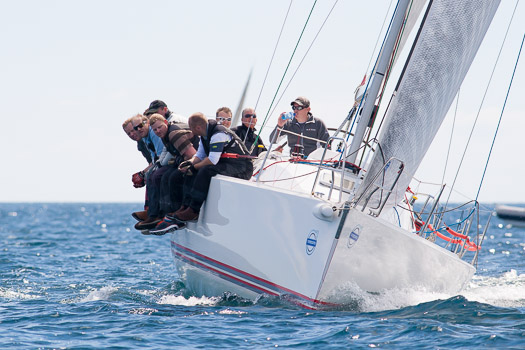
Former ICRA National Champion Storm leads IRC 3. Photo: Bob Bateman
Storm leads IRC Three by 10.5 points points from Paul O'Higgins Corby 33, Rockabill V, (Royal Irish YC). Jelly Baby is just half a point behind Rockabill V in third.
In IRC Four, Tim Cunliffe's Half Tonner, Insatiable (Royal Cornish YC) is the new leader having scored a 1,2,3 in today's three races. Paul Tingle's Corby 25, Alpaca (Royal Cork YC) has dropped to second place after struggling on today's Olympic Course. Peter Deasy's Bad Company (Royal Cork YC) had their best day so far, scoring a 4th and a win to move up to third in class. Ronan Fenton's J/35, Sky Hunter (Blackwater SC) finished the day in style, taking their first win of the regatta in Race 7.
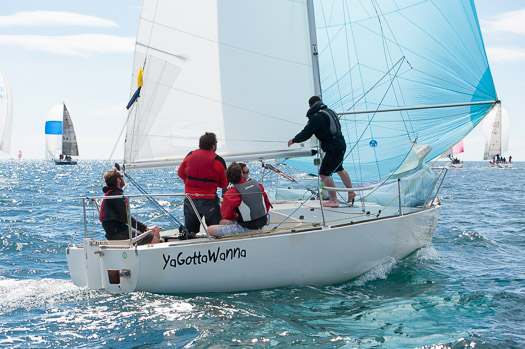
Dave Lane and Sinead Enright's YaGottaWanna. Photo: Bob Bateman
In IRC Five, it is now six straight bullets to the boys from Cobh. Jason & Domonic Losty's Quarter Tonner, Illes Pitiuises (Cobh SC). However, the team have had to fight for their supremacy, winning Race 5 by 6 seconds and Race 6 by 35 seconds. Kieran O'Connell's Quarter Tonner, Bandit (Royal Cork YC) had a consistent day to have a solid position in second place for the series. Frank O'Regan's Orient Express (Cobh SC) is the smallest keel boat at the regatta and lies third, just one point ahead of Lane & Enright's J/24, Yagottawanna (Royal Cork YC).
In the Sportsboat Class Robin & Ben O'Mahony's 1720, Spiced Beef still leads the class after scoring a third and a race win today but two yachts came into the running with excellent results today. Julian Cook's Viper 640, Oh No, won the first two races putting pressure on Spice Beef but a fifth in the last race means that Spiced Beef have a five point lead for the series. Denis Murphy's 1720, Aquatack scored three second places today to move up to third for the class, just a point behind Oh No.

Lenny Donnery's No Knomes. Photo: Bob Bateman
In IRC One White Sail, George Pettifor's Beneteau 36.7, Foxtrot had an outstanding day in Cork Harbour, winning both of today's races to become the new class leader. John Downing's Samba drops to second place, just two points off the lead. Peter O'Donovan's X-372, X Tension scored a second and third place today to move up to third for the class.
Tom McNeice's Sigma 33, Minx III won both of today's races to open up a three point lead in in IRC Two White Sail. David Borry Crockett's Sigma 33, is second with Pat Vaughan's Contessa 33, Aramis in third.
Tonight's entertainment at the Royal Cork Yacht Club Event Village includes, traditional Bag Pipes from Sessiun Ceol followed by DJ Fadd Jnr, mixing the tunes after 10pm. Racing continues tomorrow, full results available here
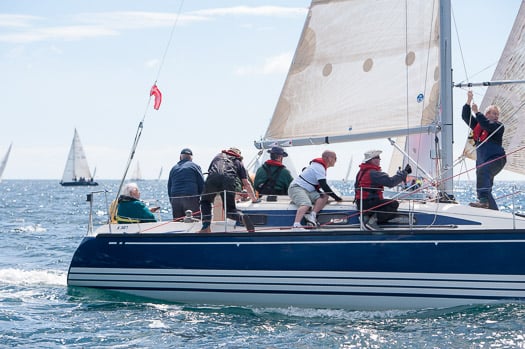
Ted Crosbie at the tiller of No Excuse. Photo: Bob Bateman
#corkweek – The fast high performance yachts racing at Volvo Cork Week enjoyed the unique Slalom Course today, the triangular course has an offset mark which forces the crew to gybe half way down the reaching leg, providing high octane maneuvres in close quarters with other yachts.
Marc Glimcher's American Ker 40, Catapult (Baltimore SC) was launched on the Slalom Course today, scoring three straight bullets. Catapult's crew include, Royal Cork's Harry Durcan, the teenage national Optimist Champion, who was beaming from ear to ear. However it was far from easy for Catapult, which will be representing Ireland in the forthcoming Brewin Dolphin Commodores' Cup. Each race was won by just seconds with three high performance yachts pushing hard; Richard Matthews' Hakes 42, Oystercatcher XXX (Royal Burnham YC), Andy Williams British Ker 40, Keronimo (Yealm YC) and Anthony O'Leary's Ker 39, Antix (Royal Cork YC).
"That is the first time I have raced on a slalom course although it is an idea we have thought about back home in Maryland." Commented Catapult's Geoff Ewenson from Annapolis USA. "Conventional windward lewards are more tactical but this course is all about speed, boat handling and sail selection, which is more akin to modern yachts flying asymmetric sails and it is a very exciting discipline. We were by no means faultless today but we have got to be happy with our results and racing a new course set up was very refreshing, something we all enjoyed."
In IRC Two, Michael Boyd's Grand Soleil 43, Quokka (Royal Irish YC) had another great day. Quokka won the first two race but dropped to fourth for the last race of the day. After four races, Quokka has a slender lead for the class from Tony Ackland's Dubois 37, Dark Angel (Swansea YSC). Conor Phelan's Ker 37, Jump Juice (Royal Cork YC) had a consistent day resulting in third place by the close of play. The intensity of the racing in IRC Two produced a tie for second place in the first of today's three races between Jump Juice and Dark Angel.
Fleet B, consisting of IRC 3, IRC 4, IRC 5 and the Sportsboat Class enjoyed three races on the Windward Leeward Course, three miles south east of Roches Point.Warm sunshine and stable conditions prevailed,with blue skies and fresh breeze coming off the land to provide a perfect classic race track.
In IRC Three, Pat Kelly's J/109, Storm (Rush YC) was in impressive form scoring a win and a second in today's races to open up an 8.5 point lead at the top of the class. Paul O'Higgins Corby 33, Rockabill V, (Royal Irish YC) sailed consistently well today to move up to second in class. Robert McConnell's A35, Fools Gold (Waterford Harbour SC) is third.
In IRC Four, Paul Tingle's Corby 25, Alpaca (Royal Cork YC) had a great day scoring two wins and a second, to climb to the top of the class. Tim Cunliffe's Half Tonner, Insatiable (Royal Cornish YC) finished the day in style with a win, to place the Cornishmen just two points off the lead. Ronan Lyden's Corby 25, Aurora (Royal Cork YC) scored two second places today to move up to third.

"Champagne sailing!" smiled Paul Tingle, skipper of Alpaca. "12 knots of breeze, a great course and really competitive racing. I just love Cork Week and today was a very special day to be out on the water. The Corby 25 is a step-up for us this season and she is a far more physical boat that we are used to, so in the last race, we were a little tired and let or concentration lapse but what a day! We are off for a crew dinner and can't wait to get going in the morning."
In IRC Five, Jason & Domonic Losty's Quarter Tonner, Illes Pitiuises had another cracking day, to win all three races and have the only perfect scoreline of the 100 yachts competing at Volvo Cork Week. Last month, Illes Pitiuises won the Corinthian Division of the Quarter Ton Cup in Cowes and look like they have brought that scintillating form with them to Volvo Cork Week. Kieran O'Connell's Quarter Tonner, Bandit had a good day on the water, moving the team up to second place above Lane & Enright's J/24, Yagottawanna. Dermott Foley's Anchor Challenge and Frank O'Regan's Orient Express posted good results today on the windward leeward course.
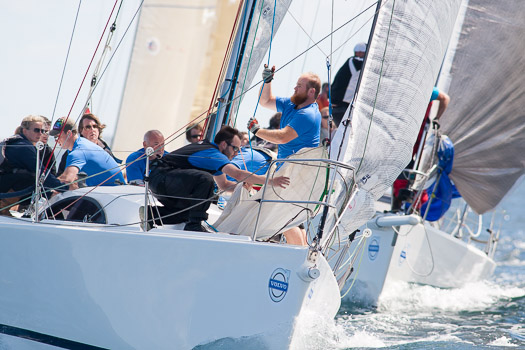
In the Sportsboat Class Robin & Ben O'Mahony's 1720, Spiced Beef still leads the class, having scored two first places today. Mike Relling's Viper 640, Viper scored their first bullet of the regatta to keep hold of second place, but by only one point, from Jimmy Nyhan's 1720, Salve racing.
John Downing's Samba leads White Sail IRC One by just two points, after winning the first of two races today. Sailed along the stunning coastline west of Cork Harbour the fleet enjoyed spectacular views in bright sunshine and a moderate breeze. George Pettifor's Beneteau 36.7, Foxtrot won the second race of the day to lift the team to second for the class. Whilst, Bryan Heffernan's Dufour 365, Aisling scored a second and a third to place third after three races. The Heffernan Family include two members in their 70s, who could not race in the spinnaker classes, a prime example of why the White Sail class is included at Volvo Cork Week.
Tom McNeice's Minx III and David Borry Crockett's Upstart are both Sigma 33S and the two yachts are enjoying incredibly close racing. Only six seconds seperated the two yachts in today's first race. Minx III and Upstart are currently tied for the lead in White Sail IRC Two. Pat Vaughan's Contessa 33, Aramis is third and a win in today's first race has lifted Clive Doherty's GK29, Phaeton to fourth.
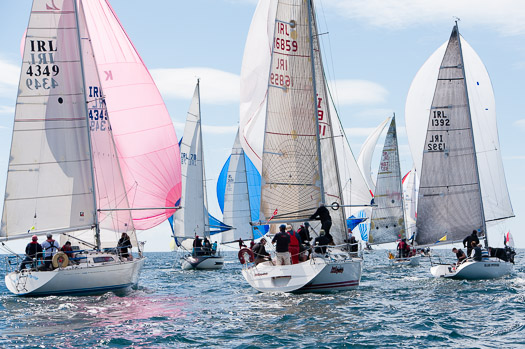
Tonight's entertainment at the Royal Cork Yacht Club Event Village includes; Samba Corcaigh Walking. Who are afloat, playing Samba drums around the pontoons. Brazil made be out of the World Cup but the party is still very much going on at Volvo Cork Week! Racing continues tomorrow,
Full results here


























